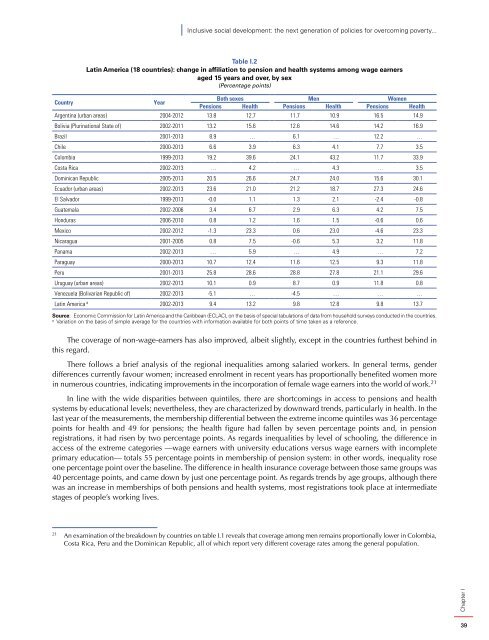Inclusive social development: The next generation of policies for overcoming poverty and reducing inequality in Latin America and the Caribbean
The Latin American and Caribbean region has achieved notable social development in the past decade. However, much remains to be done. The persisting challenges of defeating poverty once and for all and significantly reducing inequality are not only ethical imperatives but also conditions for making progress toward sustainable development, consistently with the recently adopted 2030 Agenda for Sustainable Development. Although the global economy is more complex and uncertain now than in previous years, and prospects for the region are not —in the short term, at least— particularly bright, it is crucial to secure the progress made in social development in the past decade and lose no time in tackling unresolved issues in areas where progress has been insufficient.
The Latin American and Caribbean region has achieved notable social development in the past decade. However, much remains to be done. The persisting challenges of defeating poverty once and for all and significantly reducing inequality are not only ethical imperatives but also conditions for making progress toward sustainable development, consistently with the recently adopted 2030 Agenda for Sustainable Development.
Although the global economy is more complex and uncertain now than in previous years, and prospects for the region are not —in the short term, at least— particularly bright, it is crucial to secure the progress made in social development in the past decade and lose no time in tackling unresolved issues in areas where progress has been insufficient.
Create successful ePaper yourself
Turn your PDF publications into a flip-book with our unique Google optimized e-Paper software.
<strong>Inclusive</strong> <strong>social</strong> <strong>development</strong>: <strong>the</strong> <strong>next</strong> <strong>generation</strong> <strong>of</strong> <strong>policies</strong> <strong>for</strong> <strong>overcom<strong>in</strong>g</strong> <strong>poverty</strong>...<br />
Country<br />
Table I.2<br />
Lat<strong>in</strong> <strong>America</strong> (18 countries): change <strong>in</strong> affiliation to pension <strong>and</strong> health systems among wage earners<br />
aged 15 years <strong>and</strong> over, by sex<br />
(Percentage po<strong>in</strong>ts)<br />
Year<br />
Both sexes Men Women<br />
Pensions Health Pensions Health Pensions Health<br />
Argent<strong>in</strong>a (urban areas) 2004-2012 13.8 12.7 11.7 10.9 16.5 14.9<br />
Bolivia (Plur<strong>in</strong>ational State <strong>of</strong>) 2002-2011 13.2 15.6 12.6 14.6 14.2 16.9<br />
Brazil 2001-2013 8.9 … 6.1 … 12.2 …<br />
Chile 2000-2013 6.6 3.9 6.3 4.1 7.7 3.5<br />
Colombia 1999-2013 19.2 39.6 24.1 43.2 11.7 33.9<br />
Costa Rica 2002-2013 … 4.2 … 4.3 … 3.5<br />
Dom<strong>in</strong>ican Republic 2005-2013 20.5 26.6 24.7 24.0 15.6 30.1<br />
Ecuador (urban areas) 2002-2013 23.6 21.0 21.2 18.7 27.3 24.6<br />
El Salvador 1999-2013 -0.0 1.1 1.3 2.1 -2.4 -0.8<br />
Guatemala 2002-2006 3.4 6.7 2.9 6.3 4.2 7.5<br />
Honduras 2006-2010 0.8 1.2 1.6 1.5 -0.6 0.6<br />
Mexico 2002-2012 -1.3 23.3 0.6 23.0 -4.6 23.3<br />
Nicaragua 2001-2005 0.8 7.5 -0.6 5.3 3.2 11.8<br />
Panama 2002-2013 … 5.9 … 4.9 … 7.2<br />
Paraguay 2000-2013 10.7 12.4 11.6 12.5 9.3 11.8<br />
Peru 2001-2013 25.8 28.6 28.8 27.8 21.1 29.6<br />
Uruguay (urban areas) 2002-2013 10.1 0.9 8.7 0.9 11.8 0.8<br />
Venezuela (Bolivarian Republic <strong>of</strong>) 2002-2013 -5.1 … -4.5 … … …<br />
Lat<strong>in</strong> <strong>America</strong> a 2002-2013 9.4 13.2 9.8 12.8 9.8 13.7<br />
Source: Economic Commission <strong>for</strong> Lat<strong>in</strong> <strong>America</strong> <strong>and</strong> <strong>the</strong> <strong>Caribbean</strong> (ECLAC), on <strong>the</strong> basis <strong>of</strong> special tabulations <strong>of</strong> data from household surveys conducted <strong>in</strong> <strong>the</strong> countries.<br />
a<br />
Variation on <strong>the</strong> basis <strong>of</strong> simple average <strong>for</strong> <strong>the</strong> countries with <strong>in</strong><strong>for</strong>mation available <strong>for</strong> both po<strong>in</strong>ts <strong>of</strong> time taken as a reference.<br />
<strong>The</strong> coverage <strong>of</strong> non-wage-earners has also improved, albeit slightly, except <strong>in</strong> <strong>the</strong> countries fur<strong>the</strong>st beh<strong>in</strong>d <strong>in</strong><br />
this regard.<br />
<strong>The</strong>re follows a brief analysis <strong>of</strong> <strong>the</strong> regional <strong>in</strong>equalities among salaried workers. In general terms, gender<br />
differences currently favour women; <strong>in</strong>creased enrolment <strong>in</strong> recent years has proportionally benefited women more<br />
<strong>in</strong> numerous countries, <strong>in</strong>dicat<strong>in</strong>g improvements <strong>in</strong> <strong>the</strong> <strong>in</strong>corporation <strong>of</strong> female wage earners <strong>in</strong>to <strong>the</strong> world <strong>of</strong> work. 21<br />
In l<strong>in</strong>e with <strong>the</strong> wide disparities between qu<strong>in</strong>tiles, <strong>the</strong>re are shortcom<strong>in</strong>gs <strong>in</strong> access to pensions <strong>and</strong> health<br />
systems by educational levels; never<strong>the</strong>less, <strong>the</strong>y are characterized by downward trends, particularly <strong>in</strong> health. In <strong>the</strong><br />
last year <strong>of</strong> <strong>the</strong> measurements, <strong>the</strong> membership differential between <strong>the</strong> extreme <strong>in</strong>come qu<strong>in</strong>tiles was 36 percentage<br />
po<strong>in</strong>ts <strong>for</strong> health <strong>and</strong> 49 <strong>for</strong> pensions; <strong>the</strong> health figure had fallen by seven percentage po<strong>in</strong>ts <strong>and</strong>, <strong>in</strong> pension<br />
registrations, it had risen by two percentage po<strong>in</strong>ts. As regards <strong>in</strong>equalities by level <strong>of</strong> school<strong>in</strong>g, <strong>the</strong> difference <strong>in</strong><br />
access <strong>of</strong> <strong>the</strong> extreme categories —wage earners with university educations versus wage earners with <strong>in</strong>complete<br />
primary education— totals 55 percentage po<strong>in</strong>ts <strong>in</strong> membership <strong>of</strong> pension system: <strong>in</strong> o<strong>the</strong>r words, <strong><strong>in</strong>equality</strong> rose<br />
one percentage po<strong>in</strong>t over <strong>the</strong> basel<strong>in</strong>e. <strong>The</strong> difference <strong>in</strong> health <strong>in</strong>surance coverage between those same groups was<br />
40 percentage po<strong>in</strong>ts, <strong>and</strong> came down by just one percentage po<strong>in</strong>t. As regards trends by age groups, although <strong>the</strong>re<br />
was an <strong>in</strong>crease <strong>in</strong> memberships <strong>of</strong> both pensions <strong>and</strong> health systems, most registrations took place at <strong>in</strong>termediate<br />
stages <strong>of</strong> people’s work<strong>in</strong>g lives.<br />
21<br />
An exam<strong>in</strong>ation <strong>of</strong> <strong>the</strong> breakdown by countries on table I.1 reveals that coverage among men rema<strong>in</strong>s proportionally lower <strong>in</strong> Colombia,<br />
Costa Rica, Peru <strong>and</strong> <strong>the</strong> Dom<strong>in</strong>ican Republic, all <strong>of</strong> which report very different coverage rates among <strong>the</strong> general population.<br />
Chapter I<br />
39


















